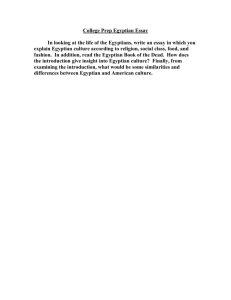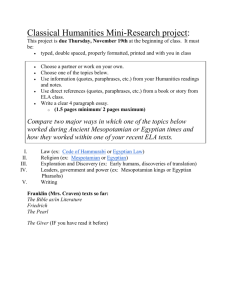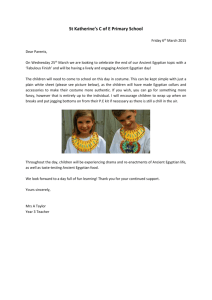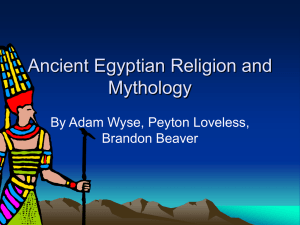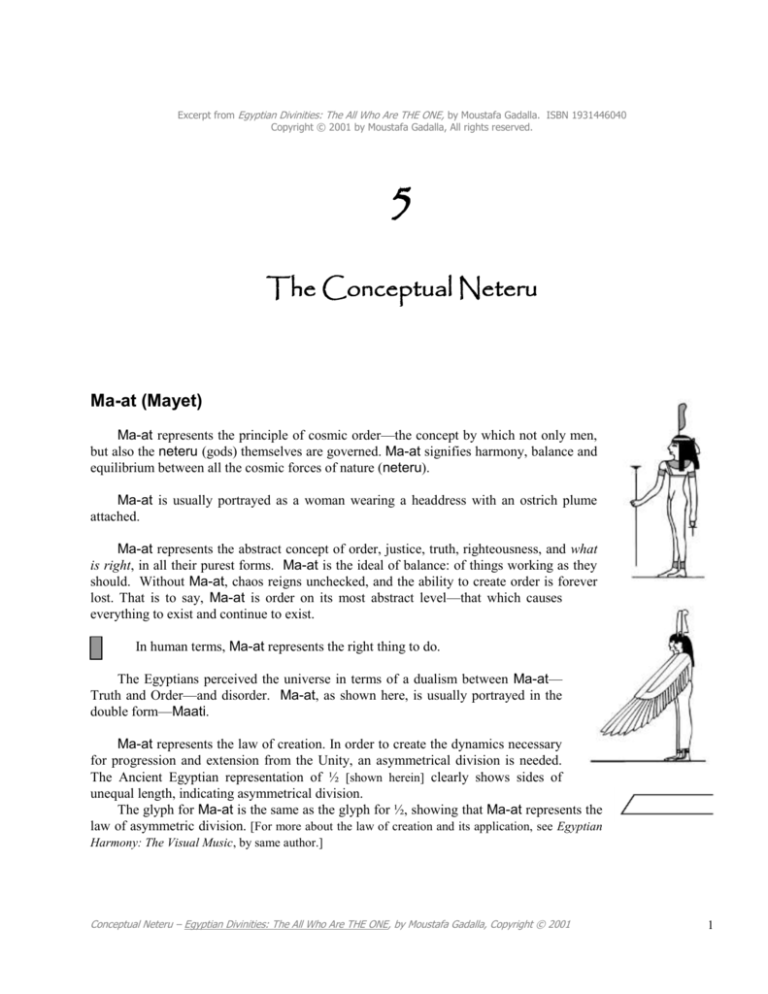
Excerpt from Egyptian Divinities: The All Who Are THE ONE, by Moustafa Gadalla. ISBN 1931446040
Copyright © 2001 by Moustafa Gadalla, All rights reserved.
5
The Conceptual Neteru
Ma-at (Mayet)
Ma-at represents the principle of cosmic order—the concept by which not only men,
but also the neteru (gods) themselves are governed. Ma-at signifies harmony, balance and
equilibrium between all the cosmic forces of nature (neteru).
Ma-at is usually portrayed as a woman wearing a headdress with an ostrich plume
attached.
Ma-at represents the abstract concept of order, justice, truth, righteousness, and what
is right, in all their purest forms. Ma-at is the ideal of balance: of things working as they
should. Without Ma-at, chaos reigns unchecked, and the ability to create order is forever
lost. That is to say, Ma-at is order on its most abstract level—that which causes
everything to exist and continue to exist.
In human terms, Ma-at represents the right thing to do.
The Egyptians perceived the universe in terms of a dualism between Ma-at—
Truth and Order—and disorder. Ma-at, as shown here, is usually portrayed in the
double form—Maati.
Ma-at represents the law of creation. In order to create the dynamics necessary
for progression and extension from the Unity, an asymmetrical division is needed.
The Ancient Egyptian representation of ½ [shown herein] clearly shows sides of
unequal length, indicating asymmetrical division.
The glyph for Ma-at is the same as the glyph for ½, showing that Ma-at represents the
law of asymmetric division. [For more about the law of creation and its application, see Egyptian
Harmony: The Visual Music, by same author.]
Conceptual Neteru – Egyptian Divinities: The All Who Are THE ONE, by Moustafa Gadalla, Copyright © 2001
1
As the model for cosmic harmony, order, balance, and equilibrium, Ma-at is associated with many
functions, such as:
1.
The administration of justice, as attested to by Diodorus. All judges of high rank in Ancient Egypt were
described as priests of Ma-at, and the chief justice wore a little figure of Ma-at around
his neck, as a badge of office.
Ma-at is sometimes represented ‘having her eyes closed’ to ensure equal justice for all
[shown herein].
Ma-at is often shown in a double form [see opposite page], representing the two
opposing sides of litigation, because the scale of justice cannot balance without the
equality of the opposing forces.
In the Hall of Judgment, Ma-at is shown in double form. The Forty-two Assessors are
under Ma-at’s charge. [For more about the Hall of Judgment and the 42 Assessors see pages
101-2.]
2.
All the activities of the Egyptian life, including building temples, were devoted to the maintenance of Maat. The temple’s rituals were based upon and coordinated with the movements of the heavens, which were
in turn manifestations of the divine cosmic law.
3.
Ma-at is maintained in the world by the correct actions and personal piety of its adherents.
The ultimate objective of the earthly man is to develop his/her consciousness to the utmost perfection; it
means that he/she becomes harmoniously tuned with nature. On Judgment Day, the successful person is
declared to be sound and pure by the Grand Jury (the 42 Assessors/jurors/neteru), as Maa Kheru—True
of Voice.
4.
Ma-at is related to the societal orderly relationship and harmony. [See Egyptian Cosmology: The Animated
Universe - Second Edition, by same author.]
5.
Ma-at is related to the harmonic laws of music. [See Egyptian Rhythm: The Heavenly Melodies, by same author.]
Ra (Re)
Ra (Re) represents the primeval, cosmic, creative force. The Ancient Egyptian text, known as The Litany of
Ra, describes Ra (Re) as The One Joined Together, Who Comes Out of His Own Members. The Ancient
Egyptian definition of Ra (Re) is the perfect representation that the Unity (whole universe) is the sum of the
many diverse entities.
In human terms, we say, “That [diversity] is what makes the world go around.”
The cosmic creative force, Ra (Re), is written as a circle with a dot or point in the
center. It is a circle moving in a circle, one and solitary. The circle symbolically
represents the Absolute, or undifferentiated Unity. The circle, appropriately enough, is the
universal archetype of creation.
Conceptual Neteru – Egyptian Divinities: The All Who Are THE ONE, by Moustafa Gadalla, Copyright © 2001
2
Ra (Re) is associated with the glyph of the eye. The most distinctive Egyptian symbol is the eye, which
plays many complex and subtle roles. The eye is the part of the body able to perceive the light, and is therefore
a symbol for the spiritual ability. The Eye of Ra (Re) is identified with Uatchet (Uadjit, Edjo, Uto, Buto,
Wadjet, Uazit), which is the serpent/cobra/uraeus—symbol of the creative potent force.
Creation is the sorting out of (giving definition to/bringing order to) all the chaos (the
undifferentiated energy/matter and consciousness) of Nun—the primeval state. Ra (Re)
represents this primeval creative force, which causes the transformation of Nun from its
undifferentiated state to differentiated energy/matter (things, objects, thoughts, forces, and physical phenomena).
Accordingly, all of the Ancient Egyptian accounts of creation exhibit well-defined, clearly demarcated stages.
The Litany of Ra describes the demarcated aspects of the creative principle—being
recognized as the neteru (gods/goddesses) whose actions and interactions in turn created the
universe. As such, all the Egyptian neteru (gods/goddesses) who took part in the creation
process are aspects of Ra (Re). There are 75 forms or aspects of Ra (Re). As such, Ra (Re) is
often incorporated into the names of other neteru (gods/goddesses) such as in Amen-Ra, RaAtum, Ra-Harakhti (shown herein), ...etc.
In human terms, Ra (Re) represents each’s ability to create. Creation can be mental,
physical, or both. This creative ability must be manifested in clearly demarcated stages.
The Egyptian texts state that the created universe came out of the mouth (of Ra), and
the mouth is the symbol of Unity—the One—in hieroglyphs. The creation process, i.e.
transformation (differentiation), is achieved through sound (the Word) as the prime mover
of the inert energy.
Tehuti (Thoth)
Tehuti (Thoth) represents the power of sound (the Word), as the prime mover of the inert energy.
Egyptian creation texts repeatedly stress the belief of creation by the Word. In the typical Egyptian story
form, it was Tehuti (Thoth), who uttered the words, commanded by Ra (Re), that created the world. In the
Egyptian Book of the Coming Forth by Day (wrongly translated as the Book of the Dead), the oldest written text
in the world, we read:
I am the Eternal...I am that which created the Word...I am the Word...
About 15 billion years ago, the condensed energy in Nun—the neutron soup—began building up, until it
finally exploded and expanded outward. The explosion was loud enough to be called the Big Bang.
Conceptual Neteru – Egyptian Divinities: The All Who Are THE ONE, by Moustafa Gadalla, Copyright © 2001
3
The divine sound (Big Bang) transformed the potential inert energy/matter in Nun into the parts of the
universe as differentiated, orderly, structured—kinetic energies—in the form of objects, thoughts, forces,
physical phenomena, etc.
Tehuti (Hermes to the Greeks, Mercury to the Romans) is called the Master of the City of Eight (Ogdad) at
Khmunu (Hermopolis), an Egyptian word meaning eight.
The Word means action. In human terms, we say, “A man of his word,” which signifies the action behind
the word. As such, Tehuti (Thoth) represents the spoken/written language, knowledge, etc.
Tehuti (Thoth) is portrayed as an ibis-headed male figure, or sometimes as all ibis. Tehuti
(Thoth) is also associated with the baboon, representing the spirit of dawn, ground zero in the
creation process.
Tehuti (Thoth) is often depicted with a crescent moon.
Tehuti (Thoth) is also referred to as the Divine Tongue, who gave names to the divine
beings that resulted from the Big Bang.
Several of Tehuti’s attributes were confirmed by Diodorus of Sicily,
It was by Tehuti [Hermes for the Greeks], according to Ancient Egyptians, that the common
language of mankind was first further articulated, and that many objects which were still nameless
received an appellation, that the alphabet were defined, and that ordinances regarding the honors
and offerings due to the neteru (gods) were duly established; he was the first also to observe the
orderly arrangement of the stars and the harmony of the musical sounds and their nature.
Book I, Section 16-1
In human terms, Tehuti (Thoth) represents the ability to do anything we want to. Tehuti is the force that
is able to transform each person’s creative potential into action—realities.
Tehuti (Thoth) represents the ability to sort-it-out / differentiate / unlock the creative energy within.
Clement Alexandrinus (200 CE) told us of 42 volumes associated with Tehuti’s domain, which include:
•
Four books about astronomy—one containing a list of the fixed stars, a second on the phenomena of the
sun and moon, and two others on the rising of the stars.
•
Several books about cosmography and geography, the course of the sun, moon, and the five planets, the
chorography of Egypt and scheme of the Nile, an account of the supplies of the temples and the lands
apportioned to them, touching on measures and the requisites of sacred things.
•
Two books on music.
•
Six books on medicine.
•
Ten books were dedicated to the honors to be rendered to the neteru (gods/goddesses) and other actions of
Egyptian piety, such as sacrifices, first fruits, vows, ceremonies, feasts, and similar things.
Conceptual Neteru – Egyptian Divinities: The All Who Are THE ONE, by Moustafa Gadalla, Copyright © 2001
4
•
Ten books about the laws of the country and of the neteru (gods/goddesses), and the instruction of the
priests.
•
A book about the instruction of youth.
The ability of Ra (Re) to create made it possible for Tehuti (Thoth) to act. But action is not possible
without the will/heart to do it. It is therefore that we find numerous depictions of Tehuti and Heru (Horus) in
the symbolic representation of tying the knot, because the will (Heru) must be accompanied by the way (action
of Tehuti). [See more on page 80.]
Some neteru (gods/goddesses) represent specific aspects of the intellectual powers of Tehuti (Thoth), as
shown below:
Hu
Hu represents the authoritative utterance. Hu is complemented by Sia (consciousness).
Sia
Sia represents the mind, or consciousness, knowledge, understanding, perception, etc. Sia is
complemented by Hu (authoritative utterance).
Heka (Hike)
Heka represents the ability to transform by using the right words. Therefore, Heka is
identified with both Sia and Hu. As such, Hu–Sia–Heka represent a trinity of active
transformation.
The right words have powerful transformational (magical) effects. The words of power
(magical words) are called Heka-u (plural of Heka).
Seshat
Seshat represents the organizational capacity of keeping records—knowledge,
information, etc.
Seshat is depicted carrying the reed pen and palette, and records deeds in eternity/space,
i.e. memory. As such, Seshat is referred to as: The Enumerator, Lady of Writing(s), Scribe,
Head of the House of the Divine Books (Archives), Lady of Builders,...
Conceptual Neteru – Egyptian Divinities: The All Who Are THE ONE, by Moustafa Gadalla, Copyright © 2001
5
As the keeper of records, Seshat represents genealogy—the keeper of the genetic history—the DNA. This
female aspect of the universe is closely related to the legitimacy of the matriarchal/matrilineal societal
framework [see more on this subject under Auset (Isis)].
Seshat (or Sefekhts—meaning seven) is usually depicted wearing the panther skin—denoting primordial
power—and a seven-petaled flower on her head.
Seshat is closely associated with Tehuti (Thoth), and is considered to be a female counterpart of Tehuti
(Thoth).
In human terms, Seshat represents the memory—this huge reservoir of knowledge, experiences,
events, traditions, past lives, history, genealogy, ...etc.
Conceptual Neteru – Egyptian Divinities: The All Who Are THE ONE, by Moustafa Gadalla, Copyright © 2001
6

